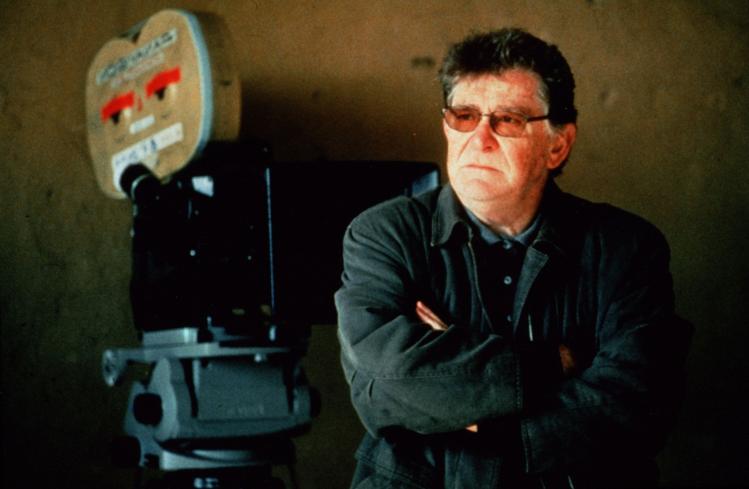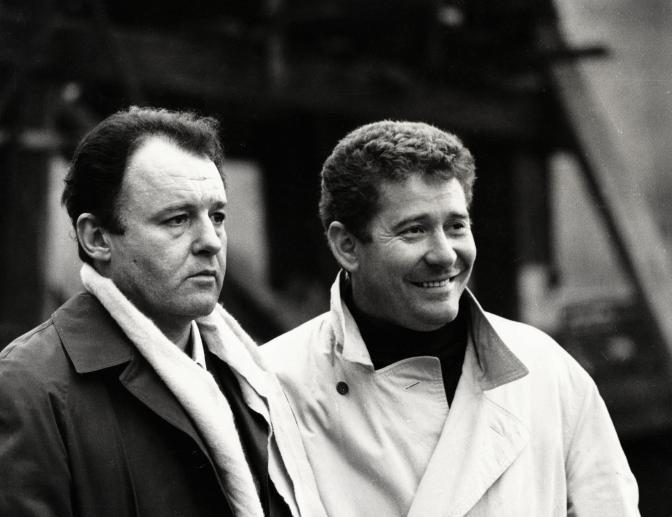
In Italian film history, the cinema of Ermanno Olmi tends to be overlooked. That’s partly understandable. His quiet, meditative films lack the bold stylistic flourishes of the more popular Italian auteurs—the gritty neorealism of Roberto Rossellini, the lush operatics of Luchino Visconti, or the soaring fantasy of Federico Fellini. Olmi’s vision is more understated, the product not only of a disciplined intellect, but also of a generous heart attentive to ordinary people and things.
Now, a year after his death at the age of eighty-six, Olmi is finally getting his due. A recent retrospective at New York’s Film at Lincoln Center screened a range of films drawn from his entire career, which spanned more than six decades, encompassing everything from industrial documentaries and historical reconstructions to literary adaptations and agricultural epics. His best-known work, The Tree of the Wooden Clogs, which centered on peasant life in rural Lombardy, won the Palme d’Or at Cannes in 1978. What makes Olmi’s films so compelling is the director’s Catholic sensibility, where the values of faith, work, community, and reverence for the rhythms of nature stand in sharp opposition to the injustices of capitalism and the spiritual emptiness of modernity. Nowhere is Olmi’s idiosyncratic Catholicism more explicit (and more radical) than in two lesser-known films I was unfamiliar with before I had the chance to see them—1988’s Legend of the Holy Drinker and 1965’s A Man Named John.
Legend of the Holy Drinker introduces viewers to Olmi’s mature understanding of the economy of grace and the price of salvation. Adapted from a novella by Austrian writer Joseph Roth, the film tells the tragic story of Andreas, a down-and-out middle-aged man living under the bridges of modern Paris. The plot unfolds like a medieval hagiography, replete with chance encounters and sudden (often comical) twists of fortune. Events are set in motion by the unbidden appearance of a kind stranger, a recent convert to Catholicism and devotee of St. Thérèse of Lisieux, who offers Andreas the handsome sum of two hundred francs to help him get back on his feet. There’s a catch, though; the stranger gently requests that Andreas eventually return the money as a holy offering before the saint’s statue, housed in the Church of Sainte-Marie des Batignolles. Andreas, “a man of honor,” readily agrees. But week after week Andreas fails to fulfill his vow, as a series of old acquaintances (and copious carafes of wine) prevent him from making his way to Mass every Sunday.
Instead of condemning Andreas’s self-destructive behavior, Olmi invites us to look on the character with dignity and compassion. The camera becomes a channel for the loving gaze of Christ, now observing Andreas’s hands as he warms them with a steaming bowl of soup, now following him as he washes and shaves by the banks of the Seine. The soft strings and oboes of Igor Stravinsky’s original score lend further grace to Andreas’s misfortunes. Much like St. Francis of Assisi or Dostoevsky’s Idiot, Andreas routinely gives (usually money, but also time) without thinking, his ready generosity trapping him in a cycle of suffering from which cannot break free. His lowly status, Olmi clarifies, isn’t entirely his fault. A set of hazy flashbacks show Andreas dancing with a former lover before accidentally killing her abusive husband (also his fellow mineworker) and landing in prison. Andreas’s trauma (and his self-hatred) is legible in his pained facial expressions, which Olmi always shoots close-up. Only twice does Andreas ever see himself as we (and God) do. Midway through the film, he wakes up from under a pile of newspapers to behold a smiling St. Thérèse; she returns at film’s end when, dying, Andreas is carried before her statue, his gift of two hundred francs at last in hand. In both instances, Olmi shows Andreas’s face in soft focus, bathed in light, as the apparition of St. Thérèse brings a measure of peace to his torments.

For all of Drinker’s Catholic vocabulary, Olmi conveys a decided ambivalence about the role of the institutional church in Andreas’s salvation. Each time Andreas attempts to find Sainte-Marie, Olmi portrays his path as a confusing labyrinth, as strangers provide circuitous, contradictory directions. The church itself, set imposingly on a broad square, is like a bunkered fortress, fronted by a row of columns and defended by an army of altar boys. In one telling scene, a crowd of well-to-do Mass-goers exits hurriedly after communion, pushing Andreas away from the church’s doors and onto the margins of the square. When he finally does manage to enter, during Mass the following week, we see Andreas standing in back, waved away by pious worshippers as the priest raises the host at the altar. Olmi’s critique is clear: the church is a stumbling block, barring rather than facilitating Andreas’s encounter with Christ.
But rather than mounting a full-scale indictment of the Catholic Church, Olmi simply wants to make us more aware of the distance between God’s ways and our own. On one hand, Drinker depicts the steady flow of grace, offered as pure gift, without merit or expectation of repayment; on the other, it shows how the church frequently fails to mirror God’s unconditional love. Closing the film with an epigraph from Roth’s novella (“May God grant all of us drinkers such a happy and beautiful death”), Olmi invites us to remember that the path of faith is hardly a sober, logical line, but rather a drunken stumble into the arms of God.
In 2013, five years before his death, Olmi published a book-length spiritual testament entitled Letter to a Church That Has Forgotten Jesus. Written during the height of the financial scandals in the Vatican and echoing the progressive Milanese Cardinal Carlo Maria Martini’s scathing critique of the hierarchy (“we’re two hundred years out of date, in need of a radical transformation”), Olmi calls for a return to the spirit of Pope John XXIII and the Second Vatican Council. Drawing from John’s teachings, Olmi focuses his critique on the distinction between the liturgy of rite—an arid, formalistic approach to the church’s tradition—and the liturgy of life, which opens up to the secular world and makes room for a plurality of perspectives. Only the latter, Olmi argues, can cure the church of its obsession with liturgical formalism and doctrinal orthodoxy, returning it to the “fresh air and limpid light” of Christ.

It’s not a masterpiece, but Olmi’s rarely screened 1965 biopic of Angelo Roncalli, A Man Named John, adapted from the spiritual classic Journey of a Soul, constitutes a succinct crystallization of these ideas, coupled with a profound denunciation of clericalism. Made just three years after John’s death, and in an era before the establishment of formal cinematic conventions for biopics and docudramas, the film stars Rod Steiger not as John but as a character called “the Mediator.” Sometimes he simply narrates events; other times, dressed in a simple black suit rather than ecclesial garments, he actually stands in for John. Today it feels like a bizarre choice, marring Olmi’s otherwise compelling recreations of John’s childhood, seminary training, and subsequent ecclesial career. (When I saw the film at Lincoln Center, a man seated in the row ahead of me kept shaking his head and groaning every time Steiger appeared on screen. I couldn’t exactly blame him.) But John’s charismatic persona loomed so large in the Italian public conscience in the mid-1960s that Olmi simply never considered trying to find a viable substitute.
For all its flaws, Olmi’s A Man Named John delivers an incisive portrait of the church—or rather, a diptych of two churches. There’s the rural church of the poor, located in far-flung regions like John’s native Bergamo, near Milan, as well as in Eastern Europe and Asia Minor (as nuncio, John was tasked with ecumenical diplomatic work in Bulgaria and Turkey). And there’s the hierarchical church, centered in Rome, and extending into the well-appointed drawing rooms in cities like Paris and Venice. Through constant crosscutting, Olmi makes his preference clear. Rome is a closed world, where seminarians amble about on rooftops reciting their breviaries rather than descending into the streets below. By contrast, remote village churches are spaces of warmth and communion. It’s here that the “liturgy of life” unfolds, as peasants attend Mass and pray the rosary aloud, different generations seated together by the hearth after sharing a communal meal of polenta.
Notably, the church on the margins is also close to the people it serves. The elderly parish priest helps young children prepare decorations and devotional statues for religious processions, while the local bishop, Giacomo Radini-Tedeschi (young Roncalli served as his secretary), ignores Vatican directives and takes the side of the workers during a contentious strike. The church’s real connection to ordinary human life gives the sacraments their meaning and efficacy: Olmi thus films all of them with reverence, giving us long, detailed close-ups of eucharistic hosts and chrism oils, but also (and perhaps most movingly), the tender laying on of hands, which takes place during Roncalli’s ordination and Radini-Tedeschi’s last rites.
A Man Named John is often cited by critics as Olmi’s only failure, but today it appears prescient, even prophetic, in a way that Olmi probably never anticipated. Late in the film, Steiger reads one of John’s many letters to his family. From a spare room in rural Bulgaria, the future pope asserts that everything he really needed to know about life, he learned before he left home at the age of ten. Communal peasant traditions and slow agricultural labor taught him the practical virtues of humility, prudence, and patience, but also the theological virtues of faith, hope, and love. Above all, John says, his childhood in the mountains and fields taught him the importance of unity, the essential oneness of all things.
That’s what I found so striking about John’s life, and about Olmi’s spiritual vision—the notion that tradition isn’t something simply asserted for its own sake, as if the point of being Catholic were a matter of strict obedience to the hierarchy or rigid adherence to a set of intellectual propositions and pious practices. The church, Olmi reminds us, is an inclusive community, a people on a journey to God—where all members, regardless of language, race, social status, political opinions, or sexuality ought to feel welcome and at home. The point of the church’s tradition is not to establish divisions or distinctions, but to draw humanity into unitive contact with Christ—ut unum sint, “so that they may be one,” as Pope John proclaims, echoing the prayer of Jesus, after his election to the papacy toward the end of the film.
Olmi lived to see the election of Pope Francis and the canonization of St. John XXIII, but we can only wonder what he would make of recent developments. Bitter arguments over church teaching and tradition continue to rage, both online and in parishes across the country, making the American church sometimes feel more like a fractious debate society than a loving place of worship and welcome. It doesn’t need to be this way. As bishop, cardinal, and then pope, John confronted many of the same divisive, fear-based social forces—nationalism and xenophobia, consumerism and spiritual despair—but he did so with kindness, with a gentility rooted in his deep reverence for life itself. It is Olmi’s great contribution to world cinema, and to the church, to give us a body of work that encourages us to look more closely at the world, helping us to be more attentive to the grace that sustains it.
